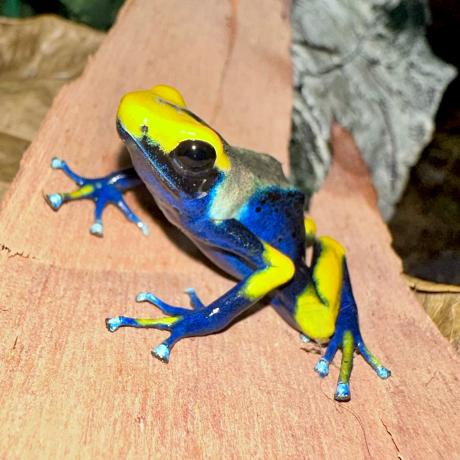

A relatively large species of Dendrobates, reaching sizes of up to 6cm in length, in variable colours and patterns depending on the locality. This species is found in nearly all of the French Guiana and parts of Surinam, Brazil and Guyana.
Dyeing Poison Dart Frogs are relatively large species, reaching sizes of around 5-6cm. They are one of the most variable species of dart frogs, with many colour and pattern combinations. Typically the base colour is black or blue, with yellow running from the head downwards in an irregular pattern of dots, stripes or patches. The legs are typically blue, the shade can vary from dark to vibrant and is often speckled with black dots. Females are usually larger than males, with circular toe pads. Males are usually smaller and more slender, with heart shaped toe pads.
They originate from tropical areas of South America, living in isolated rainforest areas of French Guiana, Guyana Brazil and Suriname.
These frogs are terrestrial, and though the frogs are small the glass terrarium should have plenty of floor space. We recommend a minimum of 60 x 45 x 30cm (24 x 18 x 12”) for two frogs, though larger is always better - especially if you plan on keeping more than two. Sexed groups can cohabit and are best kept as pairs, or trios with one female to two males; as females can express dominant behaviour towards one another, in competition for males.
The Dyeing Poison Dart Frog requires ambient temperatures of around 21-26°C during the daytime when they are most active. At night time, temperatures can be as low as 18°C, to simulate the temperature drop which happens in the wild when the sun sets. Heating by way of a basking bulb works best as it warms the air temperature, whereas heat mats provide surface temperature only and can quickly dry out the substrate. Any heat source must be controlled by using a suitable thermostat, ensuring your frogs are maintained at the optimum temperature.
It is vital to provide dart frogs with access to low level UVB lighting that sits within the parameters of Ferguson Zone 1, this helps them to produce vitamin D3 which is essential in the absorption of Calcium - keeping bones healthy and strong. This should be on for 12 hours during the day and turned off at night.
The rainforests of South America are notoriously humid, their natural humidity levels will fluctuate and can rise and fall between 70-90%. We recommend using treated tap water, bottled, or rain water as the chemicals in tap water can cause health problems for amphibians. Misting the enclosure using a spray bottle or mist system, dampens the decor, foliage and substrate. Doing this both morning and evening helps maintain humidity levels and a shallow water dish can be added, which will be readily enjoyed by the frogs. Some choose to build a waterfall within the terrarium, (making it a paludarium) which again, helps to maintain humidity without the need to mist as often.
For terrarium decor, these frogs thrive in a live planted bio-active terrarium, often using bromeliads to deposit their eggs in and rear tadpoles. Dense foliage provides natural enrichment and offers the frogs plenty of hiding places. Cork bark and vines also work well, adding to the natural look of any rainforest habitat. Artificial plants are ideal for adding plenty of coverage in areas of the tank which look a little sparse, especially while live plants are getting established. Adding in a drainage layer for bio-active setups, a soil based substrate to cover the floor and then a layer of leaf litter and moss on top can help to retain moisture. The only limit with a natural terrarium is your imagination, we suggest looking at the natural habitat of these frogs and recreating a small piece of the rainforest in your own home!
Dart frogs may be small, but they have a huge appetite! They have a fast metabolism and will need feeding daily. They will primarily eat Fruit Flies (which can be cultured to maintain a constant supply) and hatchling crickets, these are nutritious and offer enrichment by way of encouraging natural hunting and foraging behaviours. They will also prey upon other small insects such as clean up crews such as Springtails and Isopods.
On all live feeds, it is important to use a good quality supplement powder to provide an essential calcium and vitamin boost to your dart frogs. The easiest method of application is to use a spare live food tub to dust the insects lightly in supplement. We advise dusting your insects on every feed, alternating between calcium and vitamin powders according to manufacturers recommendations.e
Did you know... Poison Dart Frogs are NOT poisonous in captivity! They are so named because of their toxins being used by natives to lace the tips of darts for hunting. Their natural diet consists of ants, millipedes and mites which are extremely high in alkaloids; these toxins are accumulated in the skin of the frog. The captive diet of poison dart frogs lacks any alkaloids, meaning they pose NO risk to humans.